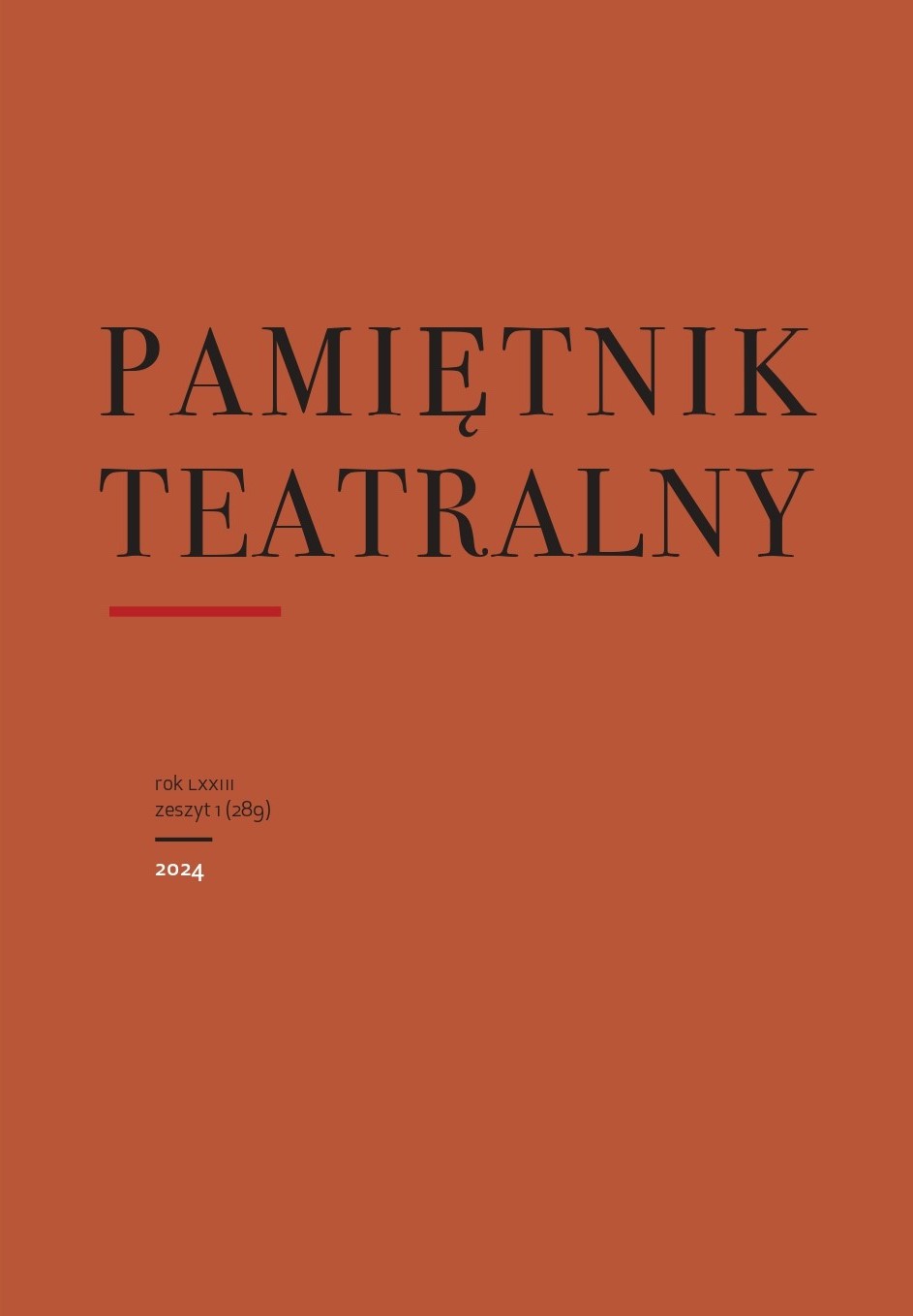The Dark Continent: «African Tales by Shakespeare» and the Experience of Transitional Community
Dorota Sosnowska
de.sosnowska@uw.edu.plUniversity of Warsaw (Poland)
https://orcid.org/0000-0002-6073-460X
Abstract
This text is an analysis of Krzysztof Warlikowski’s 2011 production, African Tales by Shakespeare, tracing the project of community taken up in the performance. The central thesis takes this to be neither a national community nor a dispersed, intersectional coalition, as Bryce Lease has formulated the difference between Polish political and traditional theater, but rather a transitional community—unstable, unsuccessful, and rooted in the experience of political transition. The author, by invoking references to the visual arts present in the performance, points to other community projects emerging from the experience of transition while showing how, when appropriated for the purposes of performance, their meanings change radically. In the masculine, phallic, and violent world of African Tales, art and philosophy born of the experience of femininity are lost, twisted, and forgotten. Among the most important threads of analysis, however, is the way racialization and racism function in the play. From this perspective, the problematic status of the community the play establishes is most clearly seen: as a community of phantasmic, aspirational, transitional whiteness.
Keywords:
«African Tales by Shakespeare», Krzysztof Warlikowski, dark continent, feminism, Other, transition, critical artReferences
Bakke, Monika. Ciało otwarte: Filozoficzne reinterpretacje kulturowych wizji cielesności. Poznań: Wydawnictwo Naukowe Instytutu Filozofii Uniwersytetu im. Adama Mickiewicza, 2000.
Google Scholar
Bojarska, Katarzyna. “Wilhelm Sasnal’s Transitional Images.” Miejsce 6 (2020). http://miejsce.asp.waw.pl/english-wilhelm-sasnals-transitional-images/.
Google Scholar
Brach-Czaina, Jolanta. Szczeliny istnienia. Warszawa: Dowody na Istnienie, 2018.
Google Scholar
Buden, Boris. Zone des Übergangs: Vom Ende des Postkommunismus. Frankfurt am Main: Suhrkamp Verlag, 2009.
Google Scholar
Cixous, Hélène. “The Laugh of the Medusa.” Translated by Keith Cohen and Paula Cohen. Signs 1, no. 4 (1976): 875–893.
DOI: https://doi.org/10.1086/493306
Google Scholar
Cleaver, Eldridge. Soul on Ice. New York: Delta, 1992.
Google Scholar
Lease, Bryce, After ’89: Polish Theatre and the Political. Manchester: Manchester University Press, 2016.
DOI: https://doi.org/10.7228/manchester/9781784992958.001.0001
Google Scholar
Loth, Eric. Love and Theft: Blackface Minstrelsy and the American Working Class. New York: Oxford University Press, 2013.
Google Scholar
Thomas, Sue. “Difference, Intersubjectivity, and Agency in the Colonial and Decolonizing Spaces of Hélène Cixous’s ‘Sorties.’” Hypatia 9, no. 1 (1994): 53–69
DOI: https://doi.org/10.1111/j.1527-2001.1994.tb00109.x
Google Scholar
Authors
Dorota Sosnowskade.sosnowska@uw.edu.pl
University of Warsaw Poland
https://orcid.org/0000-0002-6073-460X
Assistant Professor of Theater Studies at the Institute of Polish Culture (Department of Theater and Performance) at the University of Warsaw. She is a co-convener of the Historiography Working Group of the International Federation for Theater Research and an editor of Widok. Teorie i praktyki kultury wizualnej. She published the book about three actresses of the communist period in Poland, Królowe PRL. Sceniczne wizerunki Ireny Eichlerówny, Niny Andrycz i Elżbiety Barszczewskiej jako modele kobiecości (2014). She took part in the scientific projects devoted to the problem of performance documentation (ECLAP), theoretical status of sources, archives and documents in performance studies (Sources and Mediations) and performance and memory (Performing Memory). She published articles on the subject in Polish and international journals such as “Performance Research” or “Theatralia” and coedited a book devoted to the memory of worker’s theater (Robotnik. Performanse pamięci, 2017). At present, she is working on conceptualizations of the body in the art and theater of the decade of the Long ‘90s in Poland.
Statistics
Abstract views: 593PDF downloads: 478
License
Copyright (c) 2021 Dorota Sosnowska

This work is licensed under a Creative Commons Attribution-NonCommercial-NoDerivatives 4.0 International License.
The author grants a royalty-free nonexclusive license (CC BY 4.0) to use the article in Pamiętnik Teatralny, retains full copyright, and agrees to identify the work as first having been published in Pamiętnik Teatralny should it be published or used again (download licence agreement). By submitting an article the author agrees to make it available under CC BY 4.0 license.
From issue 1/2018 to 3/2022 all articles were published under a Creative Commons license CC BY-NC-ND 4.0. During this period the authors granted a royalty-free nonexclusive license (CC BY-ND 4.0) to use their article in Pamiętnik Teatralny, retained full copyright, and agreed to identify the work as first having been published in our journal should it be published or used again.
Most read articles by the same author(s)
- Dorota Sosnowska, What is Poland? History in the Periphery , Pamiętnik Teatralny: Vol. 71 No. 2 (2022)









